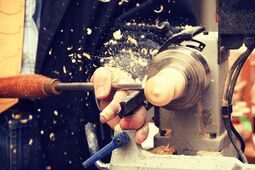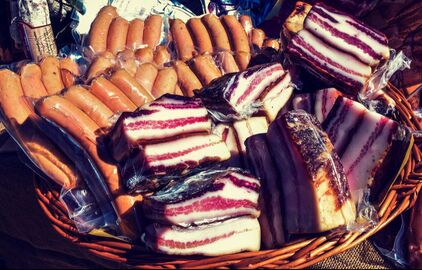
One of them is Sutrio, a 1.200 inhabitants' town right in the middle of the Carnic Alps, pretty close to the Austrian border. It's located on the left side of the Bût river and is considered one of the most ancient dwelling place in the whole Carnia area.
What's the magic formula behind its charme? Picturesque stone houses, an excellent woodcrafting tradition, a lot of mountain sports and, of course, tasty local food and wine, too.
A town for skilled hands
Sutrio's story dates back to the XIV century and its narrow, cobbled streets are lined with traditional buildings. Among them, the most interesting are the cramars' houses. Here the term cramar (“peddler” in English) defined mainly spices and fabrics' merchants, and above their front doors usually laid a special sign: a Mercury's cross, the symbol of trade.
Also lining up the streets are sculptures, wooden creations and woodcrafting workshops for which Sutrio is known as the Region's furniture centre. Its marangones, the Friulian word for carpenters, are especially skilled in carving and sculpting. Actually one of the main attractions is the renowned “Presepe di Teno”, a wooden Nativity scene that was hand-made by the late Gaudenzio Straulino: a massive piece of art, representing the whole town with mechanically operated features.
It's thus clear why the most popular events in Sutrio are the annual “Magia del Legno” (The magic of wood) and “Borghi e presepi” (Hamlets and Nativity scenes). “Magia del Legno” is a festival in September which celebrates the town's most important art, with marangones opening up their workshops to the public. And during Christmas time, thanks to “Borghi e presepi” almost in every corner one can spot a Nativity scene, both carved in wood or even played live by local people, while enjoying traditional music and food.
To the mountain's top
From the town centre, one can easily reach up to the ski-lifts that lead to Mount Zoncolan's (1.750 m) and Mount Tamai's (1.970 m) tops. So tourists can equally enjoy the 22 kilometres-long ski runs in wintertime, and no-sweat hiking paths in the summertime.
For example, from Sutrio it can take just about one-hour walk to get to Mount Tamai: and the view from there it's really worthwhile, overlooking the entire Bût Valley and the adjacent Degano Valley. Some of the panoramic paths also lead, of course, to lodges where local products are to be found. Like the extremely delicious shepherd's cottages' cheese, fresh butter and ricotta, and some vigorous grappa to cheer up.
Food & festivals
Other main events go along with typical products and dishes. Like the one completely devoted to cjarsons, a Friulian variation of ravioli, in June. In March, Sutrio celebrates pork meat with “Fums, Profums, Salums”, a feast of local salami treats.
The Hay Festival (“Fasìn la Mede”, mede meaning sheaf) on Mount Zoncolan, in July, recalls the ancient harvest time and works, and is sealed with traditional dishes. And in October, the harvest's otucome can finally be enjoyed: flours are the stars of “Farine di Flôr”, where tourists can taste any kind of flour products. And toast with Friulian wines like a Cabernet, or some fresh Ribolla Gialla and Verduzzo Friulano, maybe paired with polenta, local meat and fresh mushrooms. Well, now we're really drooling!
On Sutrio municipality's website you'll find contacts for bars, restaurants and accomodation: www.comune.sutrio.ud.it. If you want a "one of a kind" experience, you can try the "albergo diffuso" formula: sleeping in private houses as if in a hotel, taking advantage of the privileges offered by both. More info at this link.
And to keep updated with all the events, you'd better check the Proloco Sutrio's website and Facebook page.



 RSS Feed
RSS Feed